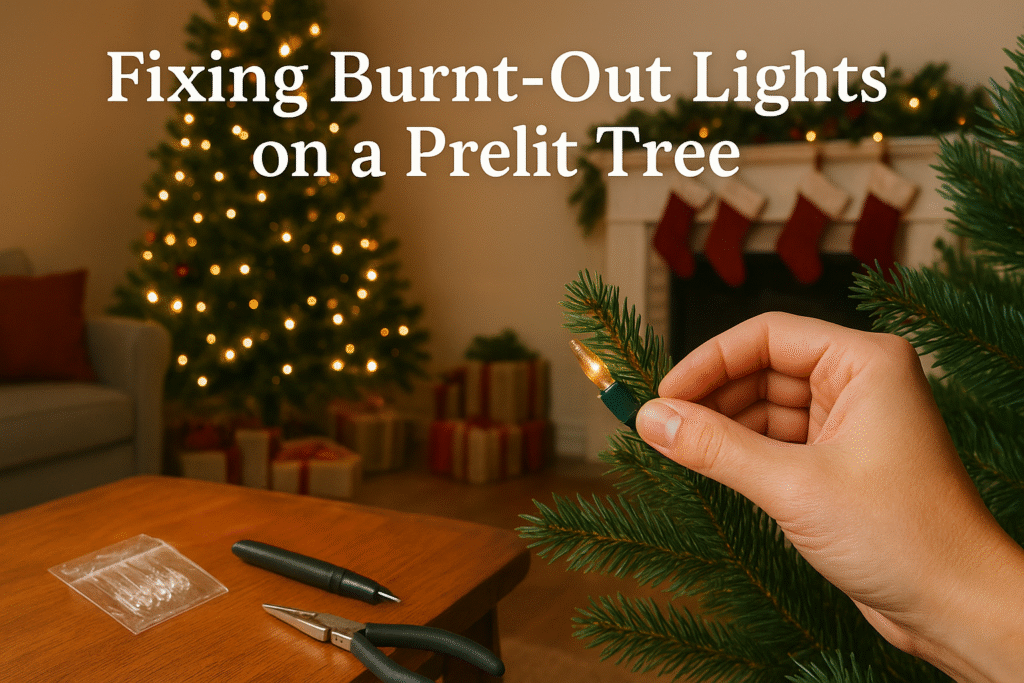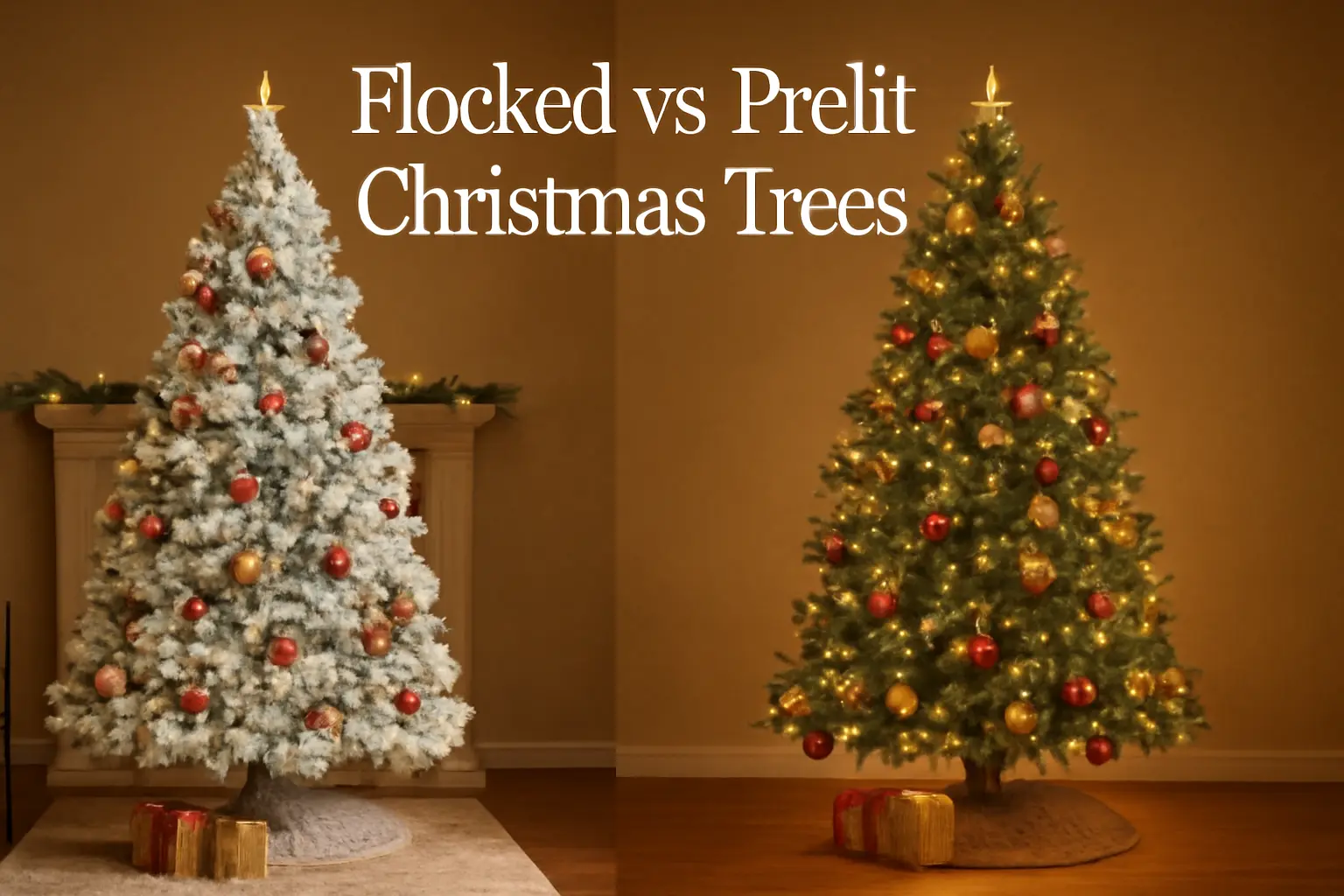When the holiday season arrives, nothing sets the festive mood quite like a glowing Christmas tree. Prelit trees have become a favorite for many households because they save time, look uniform, and eliminate the hassle of stringing separate lights. However, one of the most frustrating issues is dealing with burnt-out lights. A single bulb can sometimes cause a whole section of the tree to go dark, making the decoration look uneven and dim. Fixing burnt-out lights on a prelit Christmas tree may sound complicated, but with the right knowledge and tools, it is manageable and often straightforward. This comprehensive guide will cover everything you need to know, from identifying the problem to fixing it effectively and preventing future issues.
Understanding How Prelit Tree Lights Work
Before learning how to repair burnt-out lights, it is important to understand how prelit tree lights are wired. Most prelit Christmas trees use either series wiring or parallel wiring, and the wiring system determines what happens when a bulb goes out.
In series wiring, the electricity flows from bulb to bulb in a chain. This means if one bulb burns out or loosens, the circuit is broken, and the entire section may go dark. This is the most common reason you’ll see a half-lit tree. In parallel wiring, the bulbs are connected to the same power source independently. If one bulb goes out, the others should continue working. However, many prelit trees use a hybrid approach where a section can be affected by a single bulb failure if the wiring is sensitive.
Understanding this is essential because it changes how you troubleshoot the problem. If your prelit tree is wired in series, then even one bad bulb can darken an entire string. This is why knowing the wiring method helps narrow down the solution.
Common Reasons Why Prelit Tree Lights Burn Out
There are several causes behind burnt-out lights on prelit trees, and recognizing them makes it easier to apply the right fix.
One of the main reasons is simple bulb burnout. Just like any incandescent bulb, Christmas tree lights have a lifespan. Once a bulb reaches the end of its cycle, it burns out and may disrupt the circuit. Another common reason is a loose bulb. Since prelit trees are assembled and stored every year, it is not unusual for a bulb to get jostled loose during setup, storage, or transport. Even a slight looseness can cut the electrical connection.
Overheating is another cause. If a tree is left plugged in for many hours at a time, or if multiple electrical connections are overloaded, bulbs can overheat and fail faster. Moisture, dust, and improper storage can also damage sockets and wiring, making the lights prone to failure. Finally, fuse problems in the plug can sometimes mimic the symptoms of burnt-out lights by cutting off power to an entire section.
Safety Precautions Before Attempting Repairs
When working with lights and electrical wiring, safety should always come first. Although Christmas tree lights use low voltage, they are still connected to household electricity. Always unplug the tree before inspecting or replacing bulbs. Never attempt to repair a light string while it is connected to power.
It is also recommended to keep a pair of insulated gloves handy, especially if you are handling fragile glass bulbs that may have broken. Avoid using metal tools like tweezers or screwdrivers near the socket unless the tree is unplugged. If you suspect exposed wiring or major electrical faults, do not attempt to repair it yourself. In such cases, replacing the section or contacting the manufacturer is safer. By following these precautions, you reduce the risk of shock or injury while working on your tree.
Tools You Need to Fix Burnt-Out Lights
Having the right tools on hand makes the repair process much easier. A basic bulb replacement kit is essential and usually comes with spare bulbs and fuses. A light tester, sometimes called a bulb tester or light keeper tool, is extremely helpful. This device can quickly identify whether a bulb is faulty or if there is a break in the circuit.
Needle-nose pliers are useful for carefully pulling out bulbs that are stuck in sockets. A flashlight can help when inspecting connections in dim lighting. For prelit LED trees, you may need LED-compatible replacement bulbs, which are different from traditional incandescent bulbs. Keeping these tools in a small holiday repair kit will save time whenever lights fail during the festive season.
Step-by-Step Guide to Fixing Burnt-Out Lights on a Prelit Tree
The repair process involves systematic troubleshooting. Start by plugging in the tree and identifying which section is dark. Once the area is located, unplug the tree before working on it. Check if any bulbs appear blackened, cloudy, or visibly damaged. These are clear signs of burnout. Replace those bulbs with identical replacements.
If no visible damage is found, use a light tester. Insert the tester into each socket until you find the faulty bulb. Replace it, ensuring the bulb fits snugly into the socket. If the whole section remains out, check the fuses located inside the plug. Most tree plugs have a small compartment that houses replaceable fuses. Swap them with new ones and test again.
If replacing bulbs and fuses doesn’t work, inspect the wiring for frayed or disconnected strands. Sometimes wires bend or break during storage, cutting off power. In severe cases where wiring damage is extensive, replacing the entire light section may be necessary. While this sounds daunting, many tree manufacturers sell replacement light strings designed for their trees, making it a manageable solution.
How to Replace a Burnt-Out Bulb Correctly
Replacing a bulb requires precision to ensure the new one works properly. First, make sure you have the correct type of replacement bulb. Incandescent and LED bulbs are not interchangeable because they use different voltages and bases. Check your tree’s manual or original packaging for the right specifications.
Remove the burnt-out bulb by gently pulling it straight out of the socket. Do not twist unless the manufacturer specifies it. Insert the new bulb carefully, making sure the metal prongs align with the socket’s connectors. Push it firmly until it is fully seated. A loose bulb can prevent the circuit from completing, keeping the section dark. After replacing, plug the tree back in and check if the section lights up. If not, continue testing other bulbs until all faulty ones are replaced.
Fixing Multiple Burnt-Out Bulbs in a Section
If several bulbs have burnt out in one section, it may seem overwhelming, but the process is still systematic. Start with the most obvious burnt bulbs and replace them one by one. Sometimes, replacing a single critical bulb restores the entire section. However, if multiple bulbs are out, you may need to test each one individually.
For larger sections, using a light tester speeds up the process. Some testers can send a quick pulse through the wire, restoring power temporarily so you can see which bulbs are not functioning. Once identified, replace those bulbs and retest. It is important to replace burnt bulbs quickly because leaving them unaddressed can overload the remaining working bulbs, causing them to fail sooner.
Dealing with Fuses and Wiring Issues
Sometimes the problem lies not with the bulbs but with the fuses or wiring. Most prelit trees come with replaceable fuses located in the plug. If the entire tree or a large section is dark, replacing the fuses is often the solution. Fuses blow when there is an overload, preventing further damage to the lights.
Wiring issues are trickier. Over time, wires can fray, twist, or become pinched, especially if the tree is stored tightly in boxes. Inspect the wiring along the branches for signs of wear. If you see exposed copper or broken insulation, it is not safe to continue using that section. In such cases, the safest option is to replace the affected light string rather than attempting makeshift repairs.
Preventing Burnt-Out Lights in the Future
Prevention is as important as repair. To extend the life of your prelit tree lights, avoid leaving them plugged in for long periods, especially overnight. Use a timer to automatically turn them off after a few hours. This reduces heat buildup and saves energy.
When storing your tree, take care to fold branches gently instead of forcing them into a tight box. Protect the wiring by wrapping the sections loosely. Keep the tree in a dry, cool place to prevent moisture from damaging sockets and bulbs. Finally, always replace burnt-out bulbs promptly. Even one missing bulb in a series circuit can cause extra voltage stress on the remaining bulbs, leading to premature burnout.
Should You Repair or Replace Your Prelit Tree Lights?
A common question many homeowners face is whether repairing is worth the effort. If only a few bulbs are out, repairing is the practical solution. However, if entire sections remain dark even after replacing bulbs and fuses, and if the wiring shows signs of wear, replacing the light string may be the smarter choice.
Some newer prelit trees feature replaceable sections, making the replacement process easy. For older trees, rewiring can be more time-consuming and costly than purchasing a new tree. The decision comes down to cost, convenience, and how much sentimental or decorative value the tree holds.
Professional Repair vs DIY
While most burnt-out light issues can be fixed at home, some homeowners prefer professional repair. If your tree is expensive, extra-large, or features complex LED lighting systems, hiring a professional may save time and frustration. Professionals have specialized tools to test circuits quickly and repair or replace sections efficiently.
On the other hand, DIY repair is perfectly manageable for most families, especially with traditional incandescent prelit trees. A light tester and replacement bulbs are usually all you need to restore the festive glow. Choosing between DIY and professional repair depends on your comfort level, time, and the complexity of the issue.
Final Thoughts
Burnt-out lights on a prelit tree can dampen the holiday spirit, but they do not mean the end of your Christmas decoration. With a clear understanding of how prelit lights work, the right tools, and careful troubleshooting, you can often restore your tree’s brightness within a short time. Whether it’s replacing a single bulb, fixing a blown fuse, or replacing a whole section, each step contributes to bringing back the warm, glowing ambiance that makes the season special.
By taking preventive measures such as storing the tree carefully, replacing bulbs promptly, and avoiding overuse, you can extend the life of your prelit tree lights. Ultimately, the choice between repairing and replacing comes down to convenience, cost, and sentimental value. With this guide, you’ll have the confidence to fix your prelit tree and enjoy a beautifully lit centerpiece for your holiday celebrations year after year.





